10 Best Nylon-String Guitars for Jazz (2025 Edition)
Discover the top 10 nylon-string guitars for jazz in 2025—warm tone, great playability, and picks for every budget.
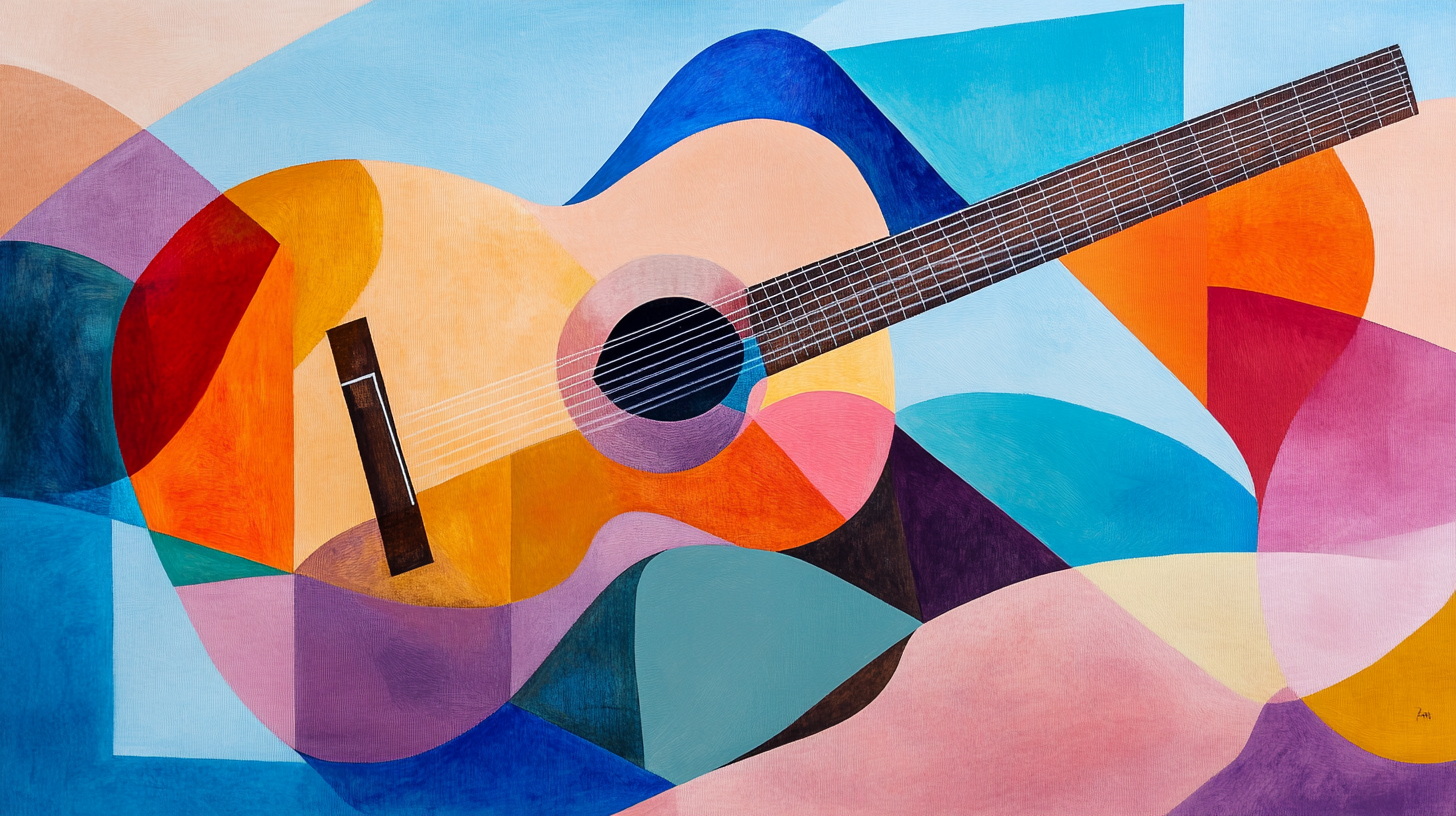
Nylon-string guitars aren’t just for classical and flamenco – they have a cherished place in jazz history and continue to inspire modern jazz guitarists. From the warm, mellow tones perfect for bossa nova comping to the articulate response ideal for intricate solos, a nylon-string guitar can add a unique voice to your jazz palette.
Icons like Charlie Byrd (who helped introduce bossa nova to the jazz world) famously played a classical Ramírez guitar on the Jazz Samba recordings, and contemporary artists like Earl Klugh and Romero Lubambo have built their signature sounds around nylon strings. Whether you’re comping Jobim chords or weaving fluid improvisations, the guitars below offer amazing playability and tone.
We’ve rounded up ten of the best nylon-string guitars for jazz in 2025, covering every budget from beginner instruments to high-end professional models. We’ll highlight why each guitar is well-suited for jazz – discussing tonal characteristics, playability (neck profiles, cutaways), electronics for amplification, and any notable jazz artists who have used them. Let’s dive in!
Comparison Table: Nylon-String Jazz Guitars at a Glance 📊
| Guitar Model | Price Range | Key Specs & Features | Jazz Pros (Why It Fits) |
|---|---|---|---|
| Yamaha C40II (Classical) | ~$150 (Budget) | Spruce top; Meranti back/sides; 52mm nut (wide); No electronics | Warm entry-level tone; great for learning bossa and jazz basics; very affordable. |
| Takamine GC5CE (Classical Cutaway) | ~$550 (Mid) | Solid spruce top; Walnut back/sides; Mahogany neck; Onboard TP-4T preamp (3-band EQ, tuner) | Stage-ready on a budget; balanced tone plugged or unplugged; cutaway for solos; reliable Takamine build for gigging. |
| Cordoba GK Studio Negra (Flamenco Cutaway) | ~$700 (Mid) | Solid Euro spruce top; Indian rosewood back/sides; 50mm nut; Thin body; Fishman Presys Blend pickup | Ultra-playable thin body; fast neck for Latin jazz runs; rich plugged-in sound with mic/piezo blend; flamenco snap for percussive comping. |
| Taylor Academy 12e-N (Crossover Acoustic-Electric) | ~$799 (Mid) | Solid spruce top; Layered sapele back/sides; 48 mm nut (1.875"); Slim neck; ES-B pickup (with tuner) | Easy transition for steel-string players; comfortable armrest and slim neck; bold, resonant tone suits jazz styles; on-board tuner/EQ for quick tweaks. |
| Yamaha NTX5 (Thinline Acoustic-Electric) | ~$1,500 (High Mid) | Solid Euro spruce top; Walnut back/sides; 48mm nut; Slim body & cutaway; Atmosfeel 3-way pickup system | High-tech electronics = fantastic amplified tone with minimal feedback; fast, slim neck feels like an electric; perfect for modern jazz, fusion, live use. |
| Godin MultiAc Nylon Encorea> (Chambered Electric) | ~$1,100 (Mid-High) | Chambered body (cedar top, maple or mahogany body); 1.9" nut; Custom dual-source pickup (piezo + sensors); Active preamp | No feedback at high volume; highly tweakable tone range; electric-like playability; gigging workhorse used in jazz and Latin bands. |
| Ibanez GA5TCE (Thinline Acoustic-Electric) | ~$300 (Budget) | Spruce top; Sapele back/sides; 48mm nut; Thin body & cutaway; Ibanez AEQ-2T preamp (2-band EQ, tuner) | Unbeatable value – easy to play, comfortable thinline body; great plugged-in sound for the price; ideal for students and casual jazz gigs. |
| Cordoba C10 (Classical) | ~$1,000 (High Mid) | All-solid wood: Cedar or spruce top; Rosewood back/sides; 52mm nut; Traditional fan bracing; No electronics (acoustic) | Rich, complex tone (concert-level) for bossa and solo jazz; high dynamic range for expressive playing; a step-up instrument for serious tone seekers. |
| Ramírez Cut 2 Studio (Classical Cutaway) | ~$3,700 (High-End) | Solid cedar top; Solid rosewood back/sides; 52mm nut; Cutaway; Fishman Prefix ProBlend (mic + undersaddle pickup) | Premium Spanish tone – legendary warmth and projection; cutaway + pro electronics = stage-friendly; top choice for pros blending classical and jazz (e.g., bossa nova). |
| Martin 000C12-16E Nylon (Crossover Acoustic-Electric) | ~$1,900 (High Mid) | Solid Sitka spruce top; Solid mahogany back/sides; 47.6mm nut (1.875"); 000-size cutaway body; Fishman Matrix VT Enhanced pickup | Distinctive crossover voice – tight bass & clear highs; familiar feel for steel-string players; easy upper-fret access; great amplified performance for jazz gigs. |
1. Yamaha C40II – Budget-Friendly Classical for Jazz Beginnings
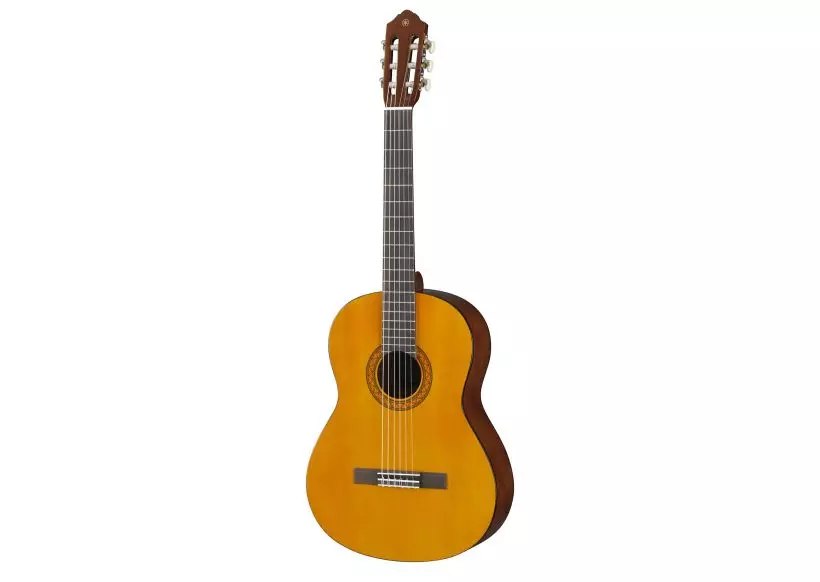
The Yamaha C40II is proof that you don’t need to spend a fortune to get started with nylon-string jazz. Priced around $150, this full-size classical is a go-to student guitar found in music classrooms worldwide*. It offers a warm, balanced tone that’s surprisingly pleasing for its price, making it ideal for exploring jazz chord-melodies and bossa nova rhythms on a budget. The C40II features a spruce top and meranti back/sides (laminate construction), a nato wood neck, and a rosewood fingerboard – materials that yield a warm, mellow sound and stable playability.
Jazz players will appreciate the C40’s comfortable action and traditional 52mm wide neck, which encourages proper fingerstyle technique. While it lacks electronics (this is a purely acoustic guitar), its tone projects well enough for practicing with a small combo or recording with a microphone. The C40’s affordability also means you can experiment with flatwound or special jazz nylon strings (like La Bella black nylon sets) to tailor the tone, without fear of damaging an expensive instrument. Overall, the Yamaha C40II is the perfect entry-point for nylon-string jazz – described as an “unparalleled combination of tone, playability and affordability” that lets beginners focus on music, not their wallet.
Available at: Amazon | Sweetwater | Thomann
2. Takamine GC5CE – Gig-Ready Nylon on a Mid-Range Budget 💡
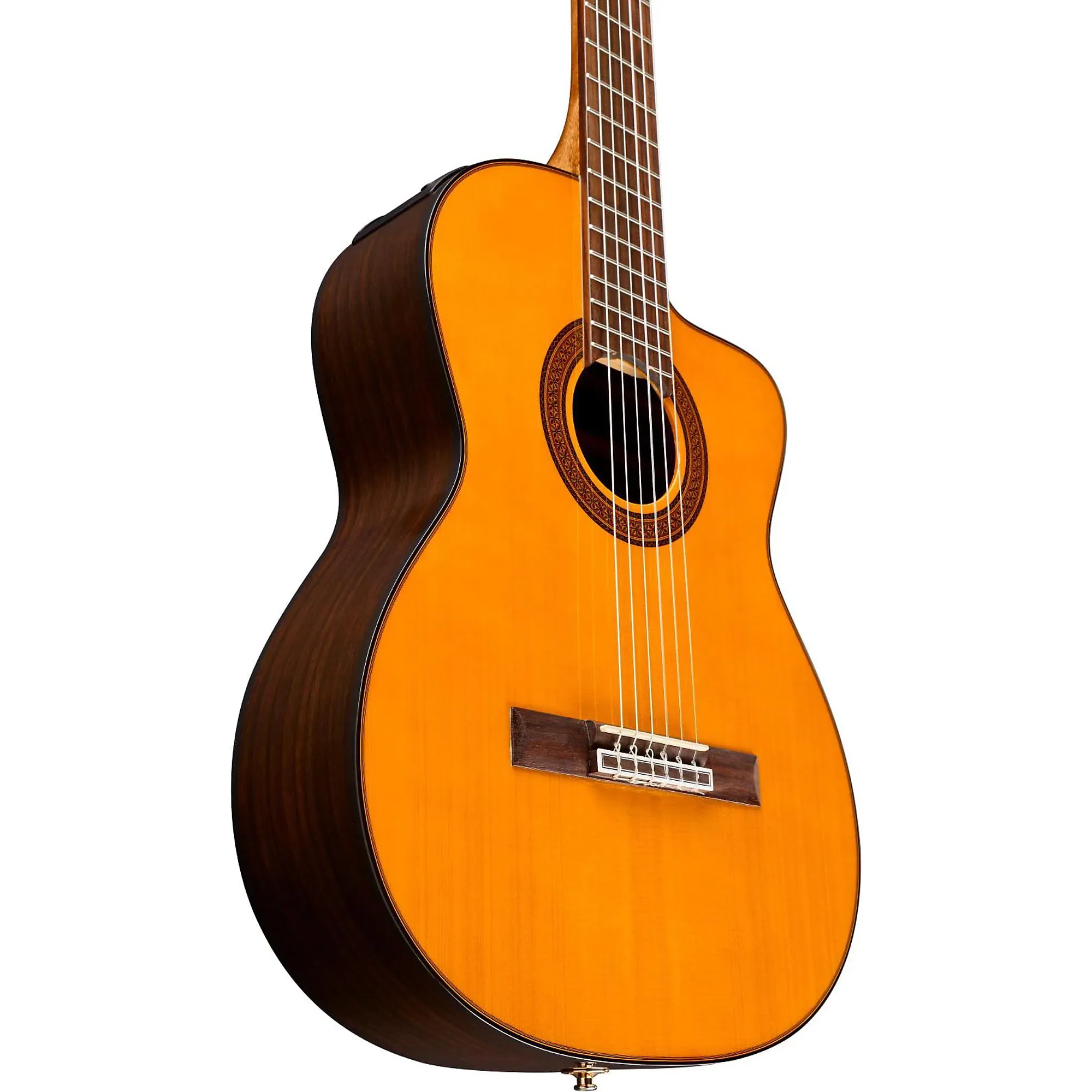
Takamine has long been a favorite for gigging musicians, and the GC5CE brings that stage-ready reliability to an affordable nylon-string guitar (around $550 new). This model is a classical acoustic-electric with a cutaway, meaning you get easy access to higher frets for solos and a built-in electronics system for amplification. The GC5CE’s specs include a solid spruce top for clear, punchy tone, layered black walnut back and sides, and a comfortable mahogany neck with rosewood fingerboard. The result is a guitar that produces a lively, balanced sound — bright enough for crisp jazz lead lines yet warm enough for mellow chord comping.
What makes the Takamine GC5CE shine for jazz is its on-board TP-4T preamp with EQ and tuner, which lets you plug directly into an amp or PA. The undersaddle pickup faithfully translates the guitar’s natural nylon tone to an amplified setting, so you can play live without worrying about feedback or mic placement. Jazz players who double on electric will feel at home with the GC5CE’s slimmer neck (slightly less wide than a traditional classical) and its slick cutaway body. Notably, Romero Lubambo – a renowned Brazilian jazz guitarist – has often performed live with Takamine nylon-string guitars, showcasing their capability in a jazz ensemble. Whether you’re comping Latin jazz rhythms or taking a solo on a sambafunk tune, the Takamine GC5CE offers great value for money as a “performance-ready guitar for not a lot of money”.
Available at: Amazon | Sweetwater | Thomann
3. Cordoba GK Studio (Negra) – Fast Flamenco Flair Meets Jazz 🔥
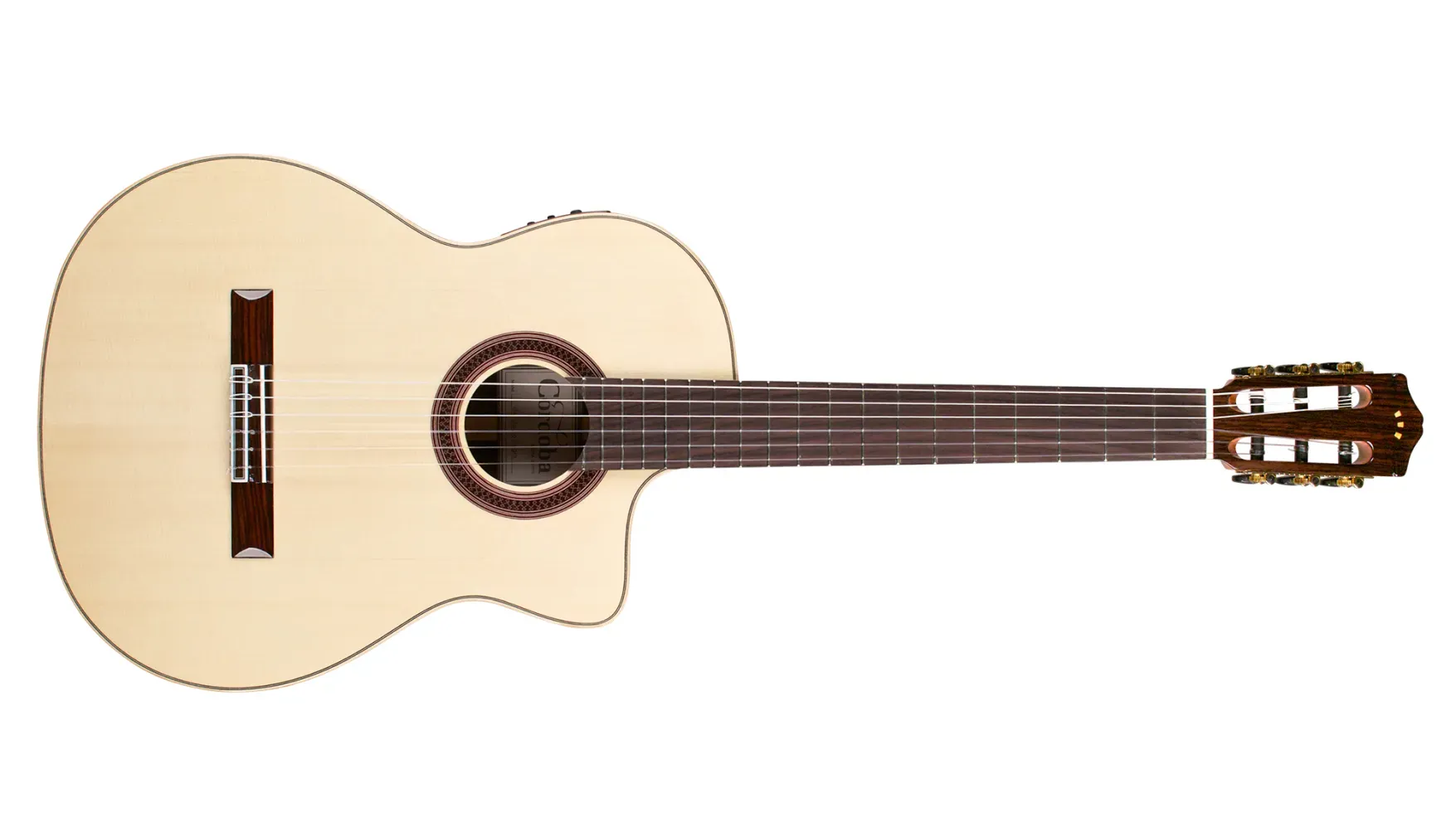
The Cordoba GK Studio is a flamenco-style nylon guitar that has become hugely popular among players who blend genres – from flamenco and Latin styles to jazz fusion. The “GK” stands for the Gipsy Kings, the famed flamenco band, and this model was designed with their input for fast playability and robust plugged-in tone. Priced in the $700 range, the GK Studio comes in two main versions: the blanca (cypress back/sides) for a brighter flamenco snap, and the Negra (Indian rosewood back/sides) for a warmer, fuller tone more akin to classical guitars. Jazz players often prefer the GK Studio Negra for its richer bass and warmer voice, which suits jazz harmonies well.
Key jazz-friendly features include a slimmed-down body depth and slightly narrower nut width (~50mm) than a typical classical. This yields an “ultra-playable” feel with lower action, perfect for quick Latin jazz runs or agile chord changes. The solid European spruce top gives the notes clarity and punch, so fast bebop lines won’t get muddy. And thanks to the Fishman Presys Blend pickup system (which pairs an undersaddle piezo with an internal mic), the GK Studio delivers a natural sound when amplified – great for gigging jazz ensembles where you need to be heard clearly.
For Latin jazz and bossa nova, this guitar really shines – you can easily execute rasgueado strums and percussive golpes, adding rhythmic drive under a jazz combo. Its pedigree in flamenco means it’s built to project and cut through a mix, yet it also responds dynamically to a lighter touch for chord-melody work. As Guitar World notes, the GK Studio is “thinner-than-usual in body depth, giving you an ultra-playable, excellent-sounding classical guitar”. In other words, it’s a nylon guitar that electric and steel-string players will find easy to adapt to. If you want to channel a bit of Paco de Lucía and a bit of Wes Montgomery on the same guitar – the Cordoba GK Studio is ready to rumble.
Available at: Amazon | Sweetwater | Thomann
4. Taylor Academy 12e-N – Easy-Playing Crossover
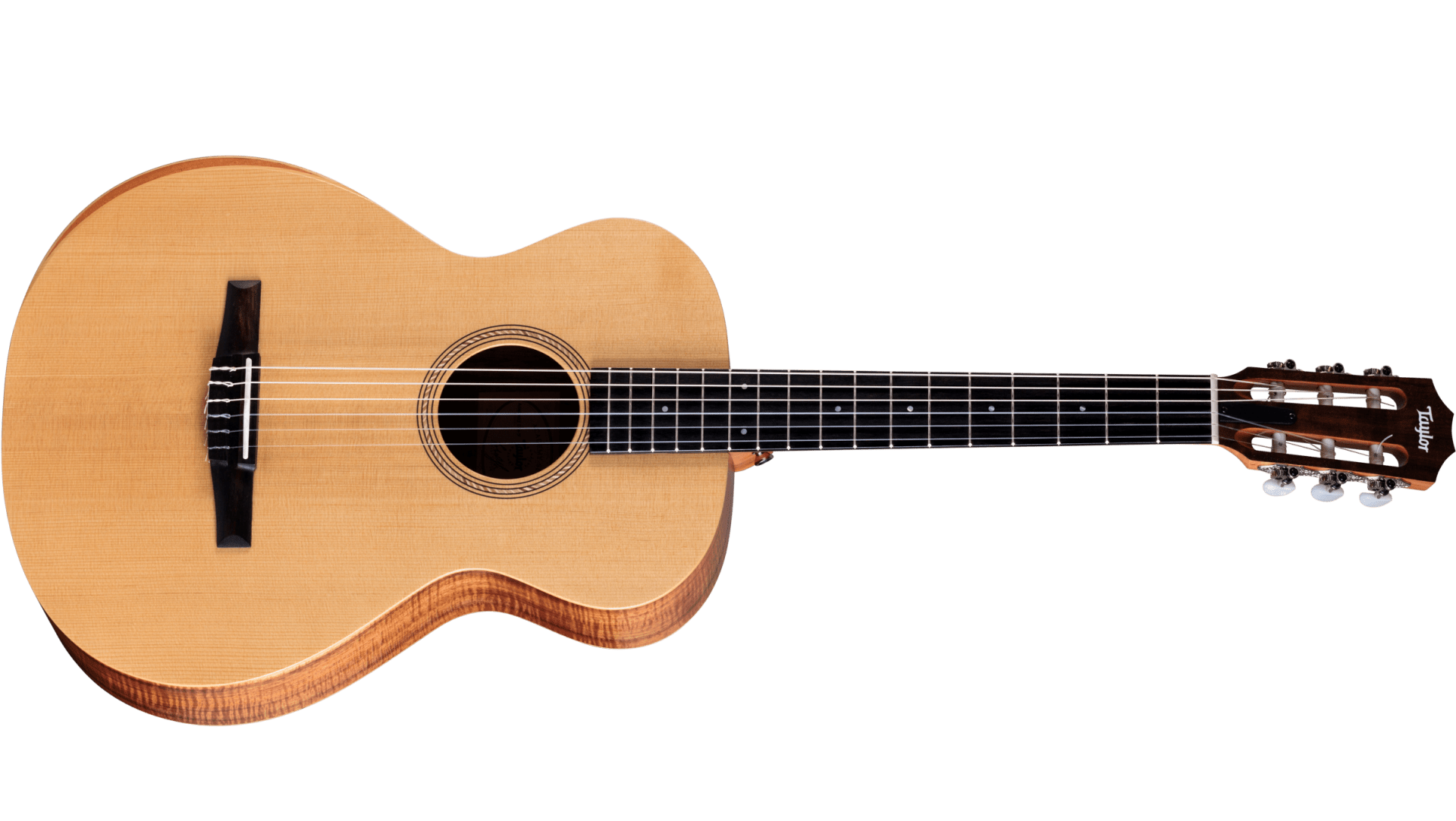
Taylor Guitars entered the nylon arena with their Academy series, and the Taylor Academy 12e-N has quickly become one of the best crossover nylon-string guitars for the money. With a street price around $799, it’s designed to give steel-string and electric players a comfortable transition to nylon strings. This guitar is a Grand Concert size acoustic-electric nylon, featuring a solid Lutz spruce top (or torrefied spruce in some editions) and layered sapele or walnut back and sides. It has a slim neck (1.875″ nut width) and a slightly shorter 24-7/8″ scale, which means the frets are a touch closer together. The result is an instrument that feels “lightweight and comfortable” in your hands, yet produces a “bold, resonant tone perfect for any style” – including jazz.
For jazz players, the Academy 12e-N offers several perks. First, the neck profile and low action make complex jazz chords and fast single-note lines easier to play compared to a traditional wide-neck classical. The guitar even includes Taylor’s signature armrest bevel on the lower bout, providing a snug and ergonomic resting spot for your picking arm – great for long practice or gig sessions without fatigue. Tonally, the spruce top and ebony fretboard yield a crisp attack and clarity that helps jazz voicings ring distinct and clear, while the layered wood body adds durability and consistent tone. Plugged in, Taylor’s ES-B electronics (which include an onboard tuner and EQ) do an excellent job of capturing the guitar’s nuances and translating them into an amplified signal*. You can confidently take this guitar to a jazz jam or coffeehouse gig, dial in your EQ, and get a natural, warm nylon tone through the PA.
Whether you’re a jazz guitarist looking to add bossa nova tunes to your set or an electric player exploring nylon-string soloing, the 12e-N is an inviting platform. It’s often praised as “an incredible quality classical guitar with the playability of a regular steel string”, so you get the best of both worlds. Taylor’s build quality ensures reliability too – even though it’s in their budget line, it “upholds the same standards of quality as Taylor’s high-end guitars…providing professional performance at a price anyone can afford”. In short, the Taylor 12e-N is a comfortable, gig-ready nylon guitar that jazz players will find immediately familiar and inspiring.
Available at: Amazon | Sweetwater | Thomann
5. Yamaha NTX5 – High-Tech, Modern Nylon String Guitar
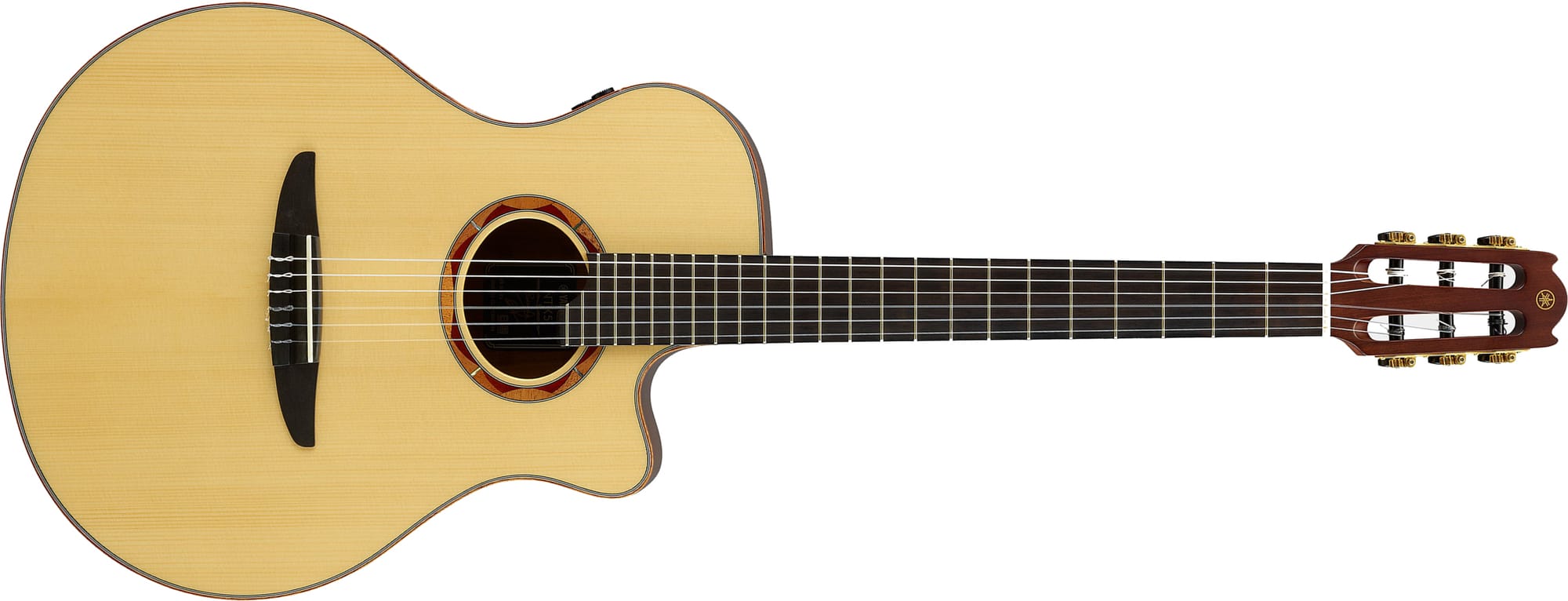
Yamaha’s NTX series is engineered for guitarists who need a nylon-string that feels stage-ready and plays fast. The Yamaha NTX5 is the flagship of this lineup (approximately $1,500), and it’s a feature-packed crossover nylon that’s perfect for contemporary jazz, fusion, and Latin styles. It sports a sleek Thinline body and a narrow (48mm) nut, so if you’re coming from a steel-string acoustic or electric, the NTX5 will feel right at home. Its build includes a solid European spruce top and walnut back and sides, plus a mahogany neck with an ebony fingerboard – a combination yielding a bright, responsive tone with pleasing warmth. Unplugged, the NTX5’s body is a bit thinner than a classical, which means it won’t boom as loud as a traditional guitar, but it’s very comfortable to hold.
Where the NTX5 truly excels is on stage. It comes loaded with Yamaha’s Atmosfeel pickup system, which is one of the most advanced electronics setups for acoustic guitars. This system uses a mix of undersaddle piezo, internal mic, and even a synthetic body resonance sensor, all blended to give an incredibly natural amplified sound with minimal feedback issues. You can confidently take the NTX5 to a big band gig or outdoor festival – it will remain feedback resistant and clear even at higher volumes*. The neck joins the body at the 14th fret and there’s a gentle cutaway, so soloing in the upper register (for that violin-like tone on jazz ballads) is a breeze.
Playability is a major highlight. As Guitar World put it, “the NTX5 has a neck that steel string players will adore”. The action is typically set low from the factory, and the fretboard radius is slightly flatter than an electric guitar but more curved than a classical, hitting a sweet spot for smooth play. Fast bop lines, chord melody arrangements, even touch-style tapping (think Pat Metheny or Tuck Andress techniques) — the NTX5 can handle it. Its tone is articulate; notes have a quick attack and a clean decay, which helps complex jazz voicings not muddy into each other. While unplugged it’s quieter, plug it in and you get a rich, full nylon tone that can cut through a mix.
In summary, the Yamaha NTX5 is like the “sports car” of nylon guitars for jazz: sleek, modern, and packed with tech. It’s ideal for the gigging jazz guitarist or doublers who need an intuitive transition from electric. From Brazilian jazz gigs to experimental fusion projects, the NTX5 delivers beautifully fast playability, hi-tech electronics, and road-worthy performance.
Available at: Amazon | Sweetwater | Thomann
6. Godin MultiAc Nylon Encore – The Jazz Performer’s Secret Weapon
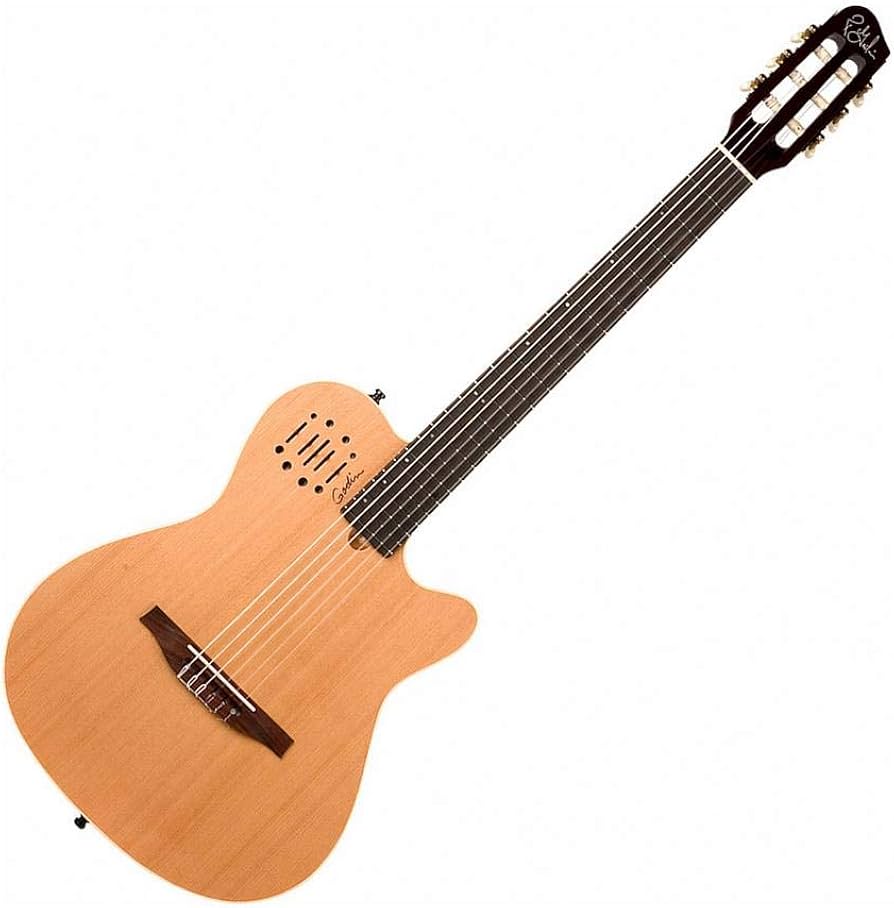
If you’ve ever seen a jazz guitarist on a large stage playing a nylon-string without worrying about feedback, chances are they were playing a Godin MultiAc. The Godin MultiAc Nylon Encore (around $1,100-$1,300 street) is a chambered-body nylon electric that has become a staple for gigging musicians in jazz, Latin, and pop settings. It’s not a traditional acoustic guitar – the body is a thin chambered slab of mahogany with a cedar top, and it’s fitted with a special dual-source pickup system (custom RMC pickups or Godin’s electronics depending on the model). The design eliminates a big sound chamber, so you can crank the volume on stage with virtually no feedback, even standing in front of a monitor.
For jazz players, the MultiAc offers the ultimate amplified nylon tone. Its electronics combine an undersaddle piezo with acoustic soundboard sensors, giving you a “huge range of plugged-in tones” and control*. Want a crisp, snappy tone for Latin jazz? Blend more piezo. Want warmth for chord solos? Dial in the body sensor for a woody resonance. The Encore model features a straightforward but effective preamp (volume, EQ sliders) that makes it easy to shape your sound on the fly. There’s also a higher model (MultiAc SA) that adds synth access if you want to connect to MIDI sound modules – some adventurous jazz players do this for adding string pads or synth leads to their palette.
Playability is akin to an electric guitar: the neck is slimmer than a classical (1.9″ nut) with a radiused richlite fingerboard, allowing fast runs and comfortable complex chords. The action can be set low without buzz, thanks to the precision of Godin’s builds. Many jazz professionals use the MultiAc when playing with ensembles because it sits in the mix cleanly – chords are clear and not too boomy, and single-note lines have a precise, almost laser-focused quality. Yet it still feels and responds somewhat like an acoustic nylon under the fingers, so you can achieve expressive dynamics.
Historically, guitars like the MultiAc descend from the old Gibson Chet Atkins solidbody nylon that legends like Chet Atkins and Charlie Byrd used on stage. Godin refined the concept, and now players such as Toninho Horta and Lee Ritenour have been known to utilize Godin nylon guitars for live work. As one reviewer put it, the Godin MultiAc is “absolutely gorgeous… great build quality and incredible sound”, albeit a bit heavy due to its solid build. In a jazz context, that translates to a rock-solid instrument that delivers night after night. If you frequently gig jazz (especially Latin jazz or bossas) and need flawless amplified tone, the Godin MultiAc Nylon Encore is hard to beat.
Available at: Amazon | Sweetwater | Thomann
7. Ibanez GA5TCE – Thinline Nylon for Jazz on a Shoestring
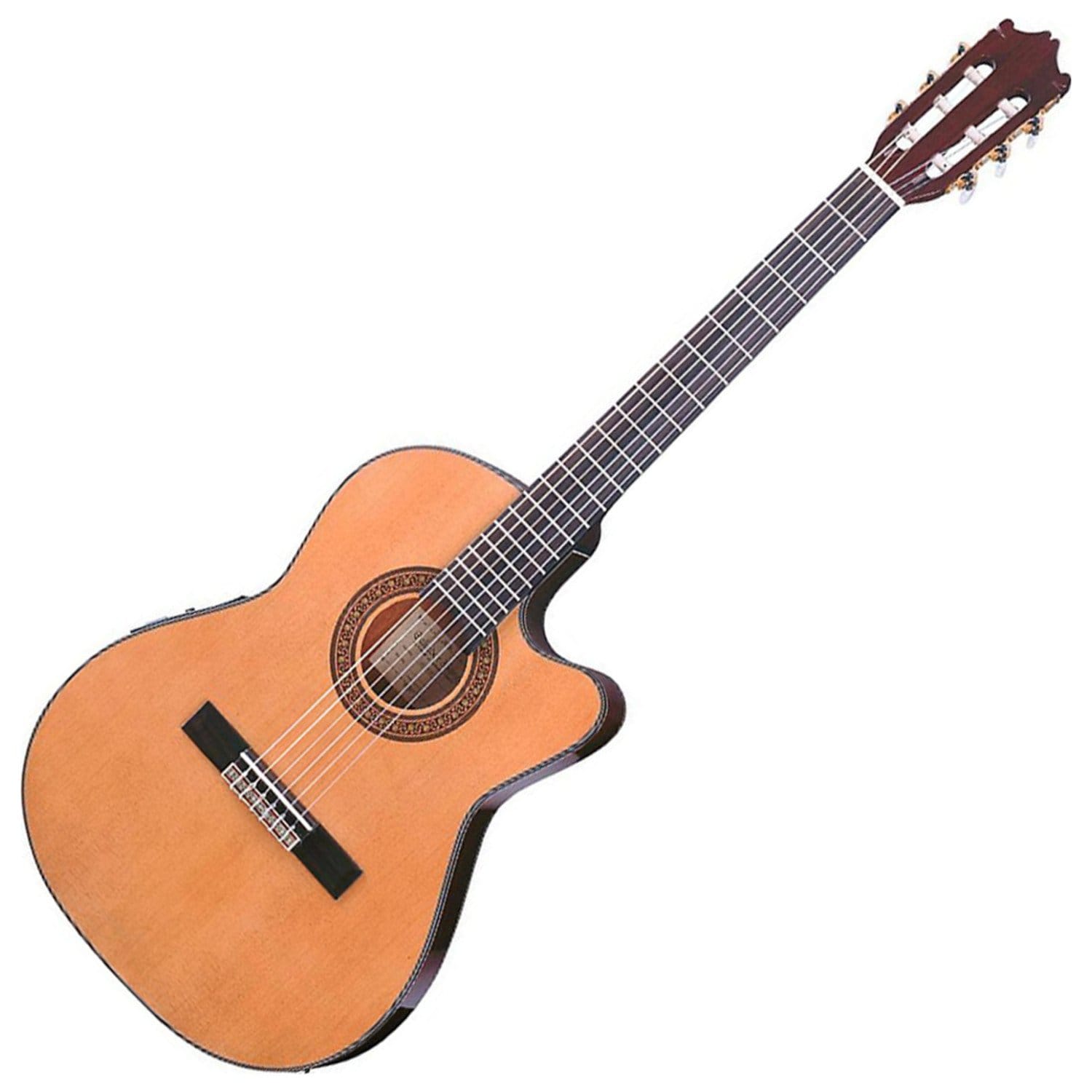
The Ibanez GA5TCE is a wallet-friendly thinline classical guitar (usually $300 or less) that has become a favorite for students and gigging players who need a reliable nylon guitar without breaking the bank. It’s often hailed as a “best buy” for entry-level acoustic-electrics, and for good reason. The GA5TCE features a slim body depth (classical cutaway shape) and a narrow neck (48mm nut), making it extremely comfortable for electric and steel-string players to adapt to. The top is spruce (laminated) with sapele back and sides, giving a decent tonal output. Unplugged, its sound is not as full as a standard classical due to the thin body, but once plugged in, this guitar truly comes alive for jazz use.
Equipped with an Ibanez under-saddle pickup and AEQ-2T preamp (with 2-band EQ and tuner), the GA5TCE allows you to shape your tone for different jazz scenarios. Need more bass for a duo gig? Dial it in. Need to cut the mids for a mellow chord comp behind a singer? Easy. When amplified, it sheds its acoustic limitations and produces a rich, usable tone that’s eager to be let loose on stage*. In fact, plugged in the GA5TCE can surprise you – players often describe it as punching above its weight, with a clear trebles and a decent body to the sound. It’s particularly great for jazz ensemble comping, where you want a percussive, controlled sound that doesn’t feedback and sits nicely under the band.
The slim body also means you can play longer sets without discomfort – it’s not cumbersome at all. As a result, many gigging musicians keep a GA5TCE as a backup or travel nylon guitar for jam sessions. It also records well direct into an audio interface, handy for home recording jazz demos or compositions. While it may not have the “traditional classical sound”* in pure acoustic mode, it compensates by being an excellent stage guitar for the money. The GA5TCE exemplifies “great value”, offering a lot of guitar for the price.
If you’re a jazz player on a tight budget or an electric guitarist who wants to experiment with nylon tones, the Ibanez GA5TCE is a solid choice. You can play Latin jazz standards, modern jazz pieces, or even use it for quiet practice. And when you step on stage at the local jazz café’s open mic night, this little Ibanez will deliver the goods without fear. “A whole lot of performance guitar for not a lot of money,” as one review noted, really sums it upguitarworld.com.
Available at: Amazon | Sweetwater | Thomann
8. Cordoba C10 – All-Solid Classical Tone
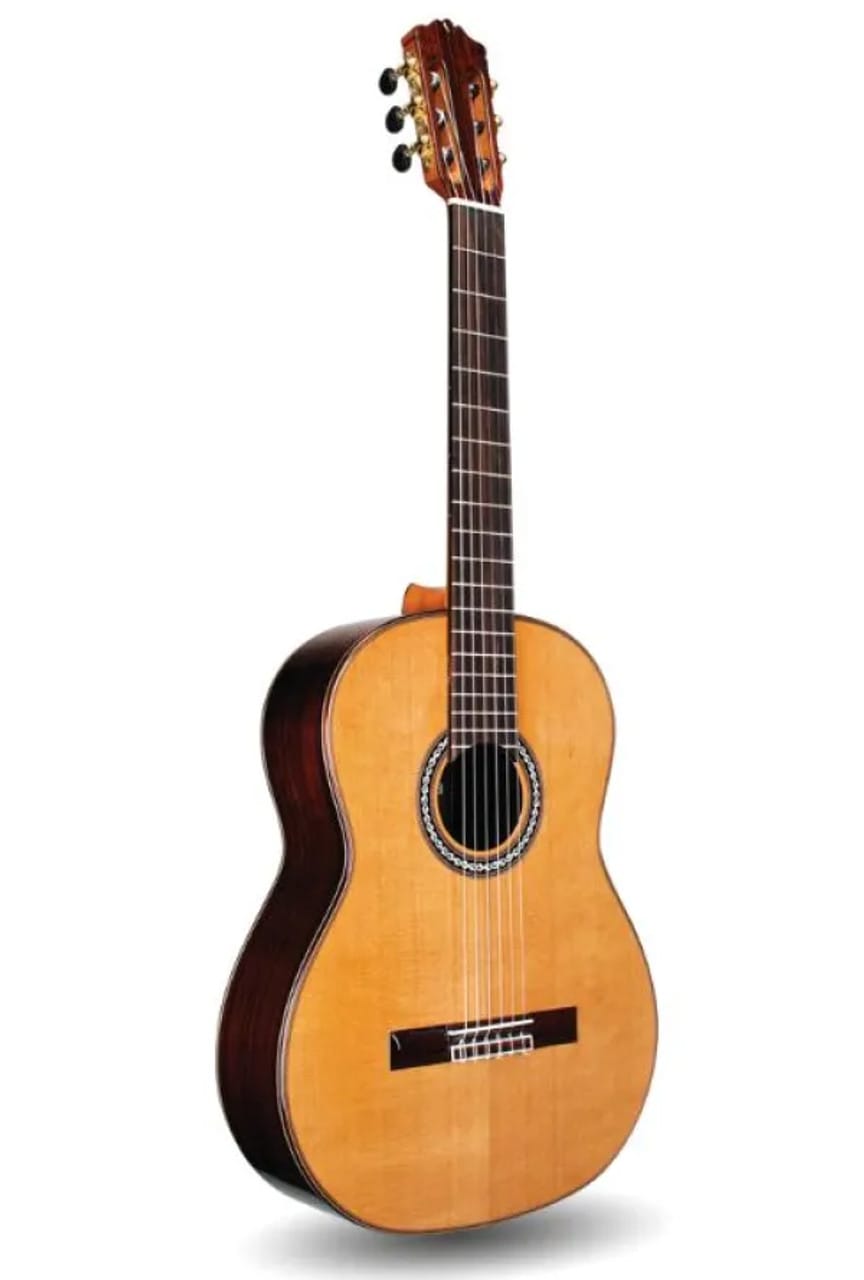
Sometimes, the pure acoustic tone of a high-quality classical guitar is what you want for jazz – especially in recording or small ensemble settings. The Cordoba C10 is an all-solid wood classical guitar (around $1,000-$1,200 new) that offers a concert-level sound at an intermediate price* . It’s part of Cordoba’s Luthier series, and it’s available with either a Canadian cedar top (for a warmer, rounder tone) or a European spruce top (for a bit more brightness and punch). Both versions have solid Indian rosewood back and sides, a mahogany neck with an ebony fingerboard, and a traditional fan-braced construction. The craftsmanship on the C10 is superb for the price – it’s handmade in a boutique workshop, not a mass-production factory, which means great attention to detail in its build.
For jazz players, the tone of the Cordoba C10 is the main attraction. The all-solid wood construction produces a rich, complex voice: the rosewood body gives it a “fat low-end, with bright, crisp treble response and complex overtones”* that make extended jazz chords sound lush and full. The cedar top variant in particular yields a warm, round attack that’s perfect for chord-melody playing – each note in a dense chord can be heard, but nothing is harsh. If you lean towards Latin jazz or bossa nova, you’ll love the warmth and intimate quality; as one description notes, the C10’s cedar/rosewood combo yields a tone that players “depend on for its intimacy and warmth”. On the other hand, the spruce top version offers more sparkle, which can help if you want your lines to project a bit more in ensemble playing.
Playability on the C10 is classical-standard: a 52mm (2″) nut and flat fingerboard. It might feel big if you’re used to electric guitars, but that wide spacing is actually beneficial for fingerstyle clarity, allowing your fingers to pluck complex jazz arrangements cleanly without muffling adjacent strings. The neck has a sleek C-shape profile and even includes a modern two-way truss rod (hidden within), ensuring you can set it up to your liking – a rarity on traditional classicals. The high fret access is somewhat limited (no cutaway here), but the trade-off is maximum soundboard area for resonance. In a recording scenario, the C10 shines: mic it up with a good condenser microphone, and you can capture a truly beautiful nylon-string sound for your jazz tracks – one with depth and character that cheap guitars can’t match.
Notable jazz guitarists who favor high-end classicals for their tone (like Gene Bertoncini or Laurindo Almeida) would appreciate what the Cordoba C10 delivers without the extreme price of a custom luthier guitar. It’s the kind of instrument that can inspire new arrangements of jazz standards simply because of its voice. If your focus is on tone quality and traditional feel, and you primarily play in environments where you can use a microphone (or perhaps add a removable soundhole pickup for small amps), the Cordoba C10 is an outstanding choice. It gives you a taste of a concert guitar’s responsiveness and nuance – in other words, a “serious classical guitar… at an affordable price” that can take your jazz playing to new heights of expressiveness.
Available at: Amazon | Sweetwater | Thomann
9. José Ramírez “Cut 2” Studio Classical – Spanish Heritage with Modern Jazz Features
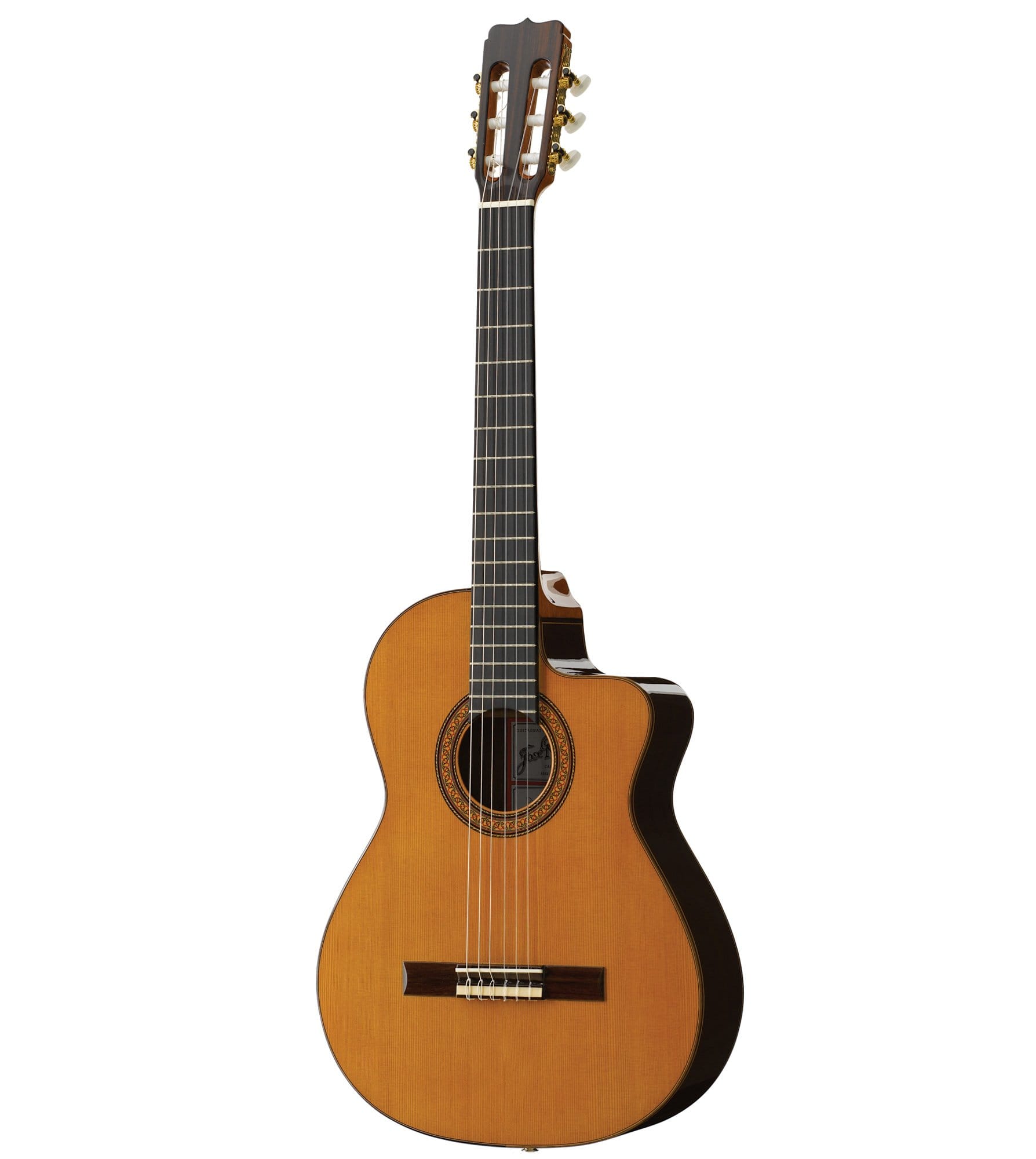
José Ramírez guitars have a legendary status in the classical and jazz-bossa world – this is the brand that guitar icon Charlie Byrd used to record Jazz Samba in the early 1960s, helping to launch bossa nova in North America. The Ramírez Cutaway 2 (Cut 2) Studio model continues that heritage, but adds features that modern players appreciate: a cutaway and electronics. This guitar is a high-end instrument (approx. $3,500-$4,000) aimed at professionals. It’s built in Spain with top-notch materials: a solid red cedar top for warmth, solid Indian rosewood back and sides for depth, and an ebony fingerboard. It also comes with a comfortable cutaway to reach the upper frets and a Fishman Prefix ProBlend preamp system installed, so it’s ready to plug in for performance.
Acoustically, the Ramírez Cut 2 is a tone monster. It has the classic Spanish nylon-string voice: deep, piano-like basses and thick, singing trebles, all with a responsive, warm character thanks to the cedar top. Strum an E7#9 chord and you’ll hear rich overtones that lesser guitars can’t produce. The dynamics are excellent – you can play whisper-soft and get a round, engaging tone, or dig in for rasgueado and get powerful projection. In short, it has the kind of “stunning tone and inspiring playability” that one expects from a concert-level guitar* . For solo jazz guitar arrangements or intimate duo settings, this fullness and balance means your chords and melodies will captivate listeners without needing any amplification.
But when you do need to amplify, Ramírez has you covered. The built-in Fishman Prefix ProBlend system is a blender preamp that uses an undersaddle pickup plus an internal microphone, allowing you to mix the two for an ideal live sound. This means you can dial in some microphone to maintain air and authenticity in your tone, while relying on the pickup for stability and attack. The result is amplified clarity and warmth that remain true to the guitar’s voice*. Jazz players who tour love this setup – it’s versatile enough for any venue, from a small club to a large auditorium. And with the cutaway, improvising over jazz changes above the 12th fret is much easier than on a standard classical.
The playability is also excellent: a well-shaped Spanish cedar neck with an ebony fretboard gives a smooth feel, and the action is typically set up on the low side at the Ramírez workshop, making fast runs and barres easier. High-quality tuners (usually gold Gotoh or Ramírez’s own) ensure stable tuning – critical for those long sets or recording sessions. The craftsmanship and detailing (like an inlaid rosette, purfling, and high-gloss finish) are beautiful, so it’s an instrument that inspires pride of ownership as well.
In a jazz context, this Ramírez is perfect for someone who plays a lot of Latin jazz, solo guitar gigs, or classical-jazz crossover pieces. It offers the traditional sound beloved in bossa nova (think of João Gilberto’s gentle comping, or **Baden Powell’s soulful nylon-string melodies) with the convenience of modern playability and electronics. It’s a guitar that “combines exceptional craftsmanship with modern features”, truly “the perfect choice for serious players”* who demand the very best. If you’re a professional or dedicated amateur who wants a lifetime nylon guitar for jazz, the José Ramírez Cut 2 Studio should be high on your list.
Available at: Reverb.com | Thomann
10. Martin 000C12-16E Nylon – Steel-String Icon Meets Jazz Nylon
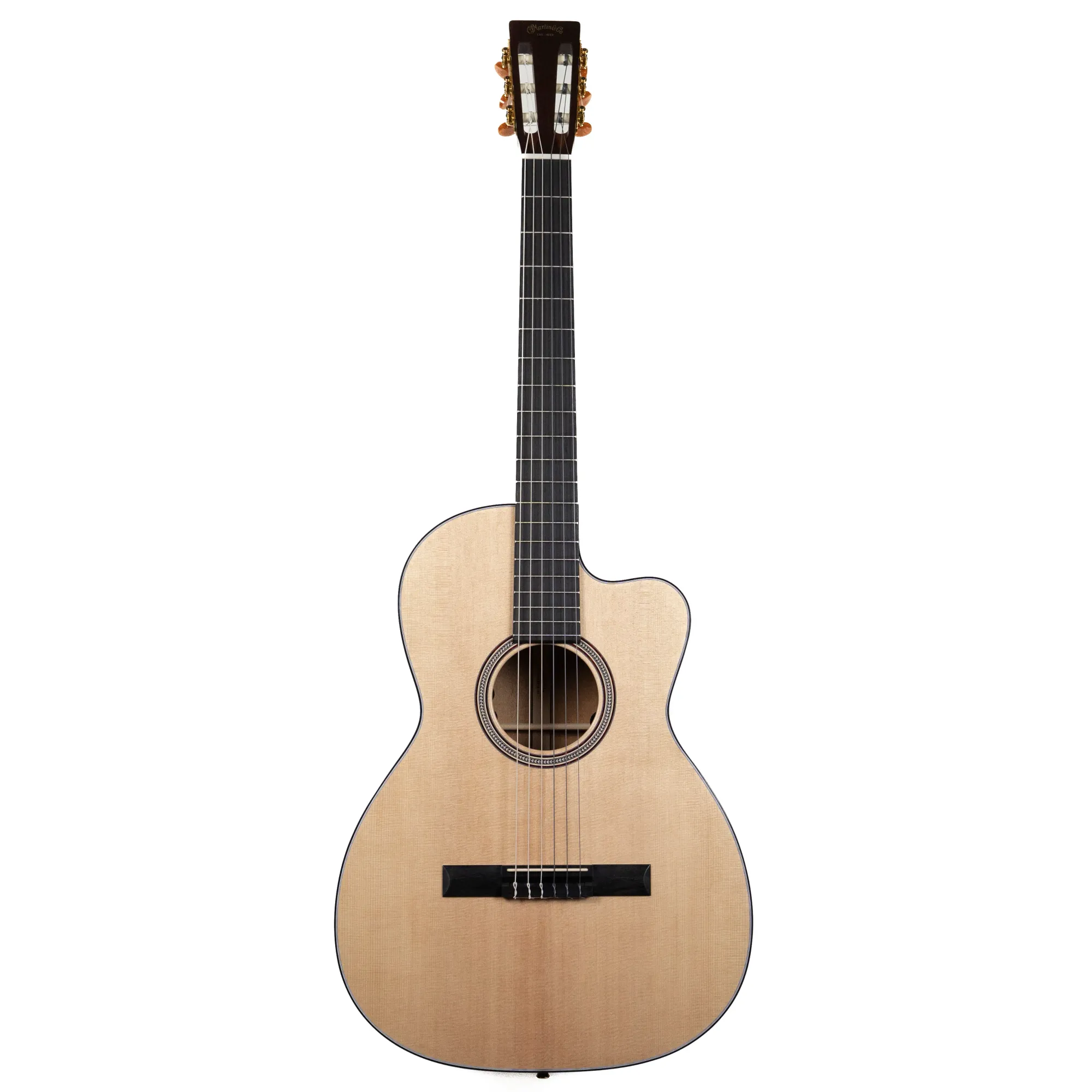
Why it’s great for jazz: Martin is a name synonymous with steel-string acoustics, but with the Martin 000C12-16E they ventured into nylon-string territory – and the result is a uniquely charming crossover guitar that jazz players can appreciate. This Martin model (approximately $1,899 street) takes a traditional 000 (auditorium) steel-string body shape and reimagines it for nylon strings. It has a solid Sitka spruce top with solid mahogany back and sides, a combination rarely seen in classical guitars (which typically use rosewood or maple). This wood combo, along with Martin’s X-bracing, produces a tone that is clear and focused, with a strong fundamental. As one review noted, the mahogany back/sides give it a “rich, tight bass with wonderful top-end articulation,”* and the unorthodox mahogany choice “works a treat”* in this context – delivering a sound that’s a bit different from Spanish guitars but absolutely delightful in its own way.
For jazz players, the crossover design features are key: The 000C12-16E has a slightly narrower nut width (~1.875″) than standard classical, a radiused fingerboard, and a neck join at the 12th fret with a cutaway. This means it feels more like a Martin steel-string to play – very comfortable if you’re used to an OM/000 model. The cutaway allows access to higher frets, so soloing or playing chord inversions up the neck is no problem. And unlike traditional classicals, this Martin comes stock with a Fishman Matrix VT Enhanced pickup system, which includes an under-saddle pickup and an enhance transducer, plus soundhole-mounted controls. Plugged in, it gives a reliable, feedback-resistant performance, with the Fishman system capturing the guitar’s tonal character faithfully (including that tight bass and sparkling treble).
Tonally, Martin’s nylon has its own voice that works great for jazz fusion or modern jazz compositions. Chords have a nice punch and clarity – likely due to the spruce/mahogany combo – and single notes are very even. It might lack a bit of the enveloping warmth of a cedar/rosewood classical, but in a band mix that’s actually a positive: it cuts through with definition. If you’re comping Freddie Green-style four-to-the-bar (yes, some jazzers do this on nylon for a different texture!), the notes stay distinct. And if you flatpick on occasion or use a pick for fast lines (some jazz players do on nylon), the guitar responds well, since it was designed with a crossover mindset (Martin even suggests it’s for classical players looking to branch out*).
The 000C12-16E Nylon is also a handsome guitar – it looks like a Martin 000 with a slotted headstock. The build quality is top-notch (made in the USA), and it offers something that many nylon-string guitars don’t: familiarity for steel-string veterans. It’s clearly “more of a crossover guitar than a concert instrument for classical players,” as one expert wrote. That is exactly why it can appeal to jazz guitarists, who often come from a steel-string or electric background. In summary, Martin’s 000C12-16E is an “unorthodox” nylon that brings a fresh tonal flavor to jazz – one that combines Martin’s legendary playability with the sweet sound of nylon strings. For the jazz player who wants to stand out with a different kind of nylon tone (or simply loves Martin guitars), this model is a compelling choice.
Available at: Amazon | Sweetwater | Thomann
Final Tips
When choosing a nylon-string for jazz, consider your playing context. If you’ll play amplified with a band, a crossover or acoustic-electric (with a good pickup) is invaluable. For primarily solo or recording work, a full-bodied classical like the C10 or Ramírez might reward you with a richer acoustic sound. Don’t forget to try different string sets too – normal vs. hard tension, or specialty jazz/flamenco strings – they can significantly affect feel and tone*.
Lastly, have fun with it! 🎶 Jazz is all about personal expression. Whether you’re channeling the mellow bossa vibes of João Gilberto or crafting modern fusion solos, the right nylon-string guitar will inspire new creative directions. Test these guitars at your local shop if possible, listen to recordings of jazz players using nylon strings, and choose the one that resonates with your music.
Do you have a favorite nylon-string guitar for jazz? Let us know in the comments! And if you found this guide helpful, feel free to share it. Now go forth and make some beautiful music – the sophisticated world of nylon-string jazz guitar awaits you.

